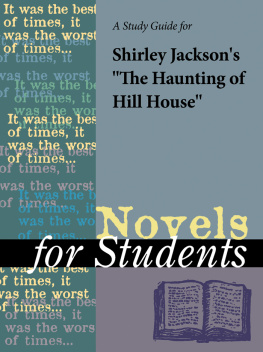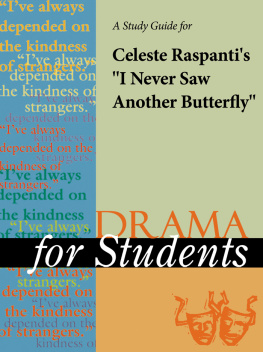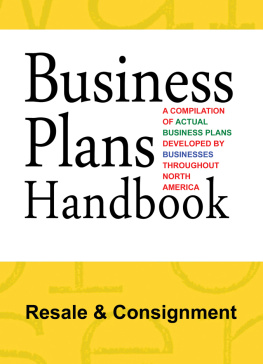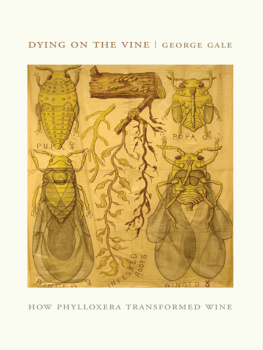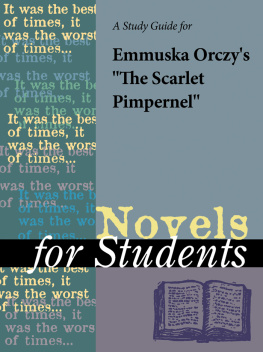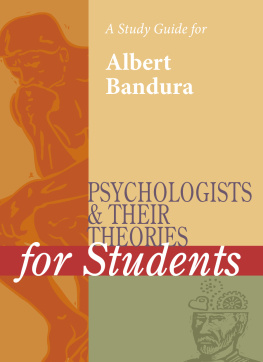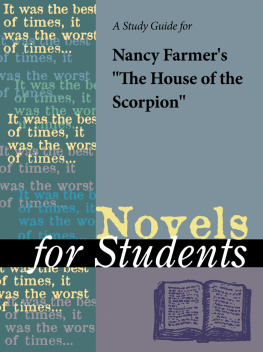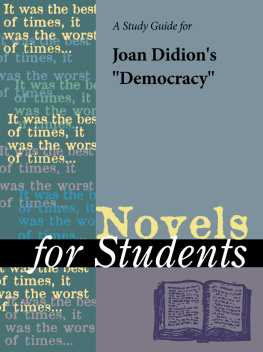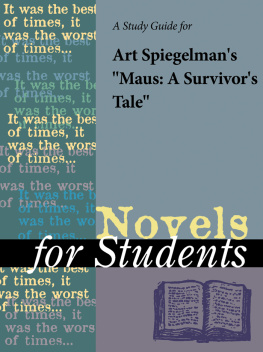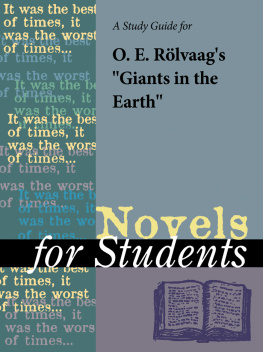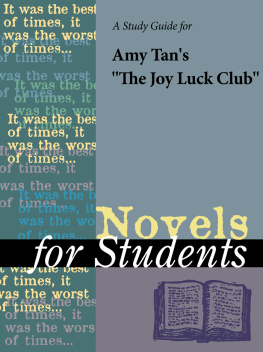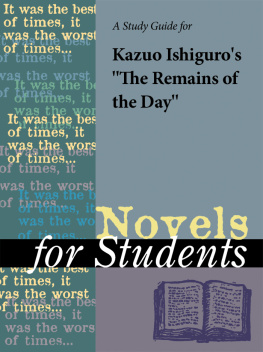TABLE OF CONTENTS
Guide
Novels for Students, Volume 37
Project Editor: Sara Constantakis
Rights Acquisition and Management: Margaret Chamberlain-Gaston, Jackie Jones
Composition: Evi Abou-El-Seoud
Manufacturing: Rhonda Dover
Imaging: John Watkins
Product Design: Pamela A. E. Galbreath, Jennifer Wahi
Content Conversion: Katrina Coach
Product Manager: Meggin Condino
2011 Gale, Cengage Learning
ALL RIGHTS RESERVED. No part of this work covered by the copyright herein may be reproduced, transmitted, stored, or used in any form or by any means graphic, electronic, or mechanical, including but not limited to photocopying, recording, scanning, digitizing, taping, Web distribution, information networks, or information storage and retrieval systems, except as permitted under Section 107 or 108 of the 1976 United States Copyright Act, without the prior written permission of the publisher.
Since this page cannot legibly accommodate all copyright notices, the acknowledgments constitute an extension of the copyright notice.
For product information and technology assistance, contact us at Gale Customer Support, 1-800-877-4253.
For permission to use material from this text or product, submit all requests online at www.cengage.com/permissions.
Further permissions questions can be emailed to permissionrequest@cengage.com
While every effort has been made to ensure the reliability of the information presented in this publication, Gale, a part of Cengage Learning, does not guarantee the accuracy of the data contained herein. Gale accepts no payment for listing; and inclusion in the publication of any organization, agency, institution, publication, service, or individual does not imply endorsement of the editors or publisher. Errors brought to the attention of the publisher and verified to the satisfaction of the publisher will be corrected in future editions.
Gale
27500 Drake Rd.
Farmington Hills, MI, 48331-3535
ISBN-13: 978-1-4144-6700-9
ISBN-10: 1-4144-6700-1
ISSN 1094-3552
This title is also available as an e-book.
ISBN-13: 978-1-4144-7366-6
ISBN-10: 1-4144-7366-4
Contact your Gale, a part of Cengage Learning sales representative for ordering information.
Printed in Mexico
1 2 3 4 5 6 7 15 14 13 12 11
The Haunting of Hill House
Shirley Jackson
1959
Introduction
Shirley Jackson's 1959 novel The Haunting of Hill House is an emblematic modern ghost story that resuscitated an abandoned genre and provided a framework for new gothic novels by authors ranging from Joyce Carol Oates to Stephen King. The novel is satirical, subverting the restricted lives of housewives in prefeminist America as much as the gothic genre itself. But to classify the novel simply as horror is to undervalue it as genre fiction, rather than literary fiction, where its complexity and quality more naturally place it. The Haunting of Hill House is heavily indebted not only to the gothic traditiongoing back to novels like The Castle of Otranto (1764) by Horace Walpolebut also to first-wave feminist literature like The Yellow Wallpaper (1892), by Charlotte Perkins Gilman, from which Jackson found inspiration for much of her plot and theme, reading the horror-story tradition as an allegory for women's lives in a male-dominated society. The Haunting of Hill House also grew out of extensive research that Jackson conducted into the pseudoscientific world of parapsychology. She introduces themes such as ghost hunting, extrasensory perception, and the strange paradoxes investigated by Charles Fort to a mainstream literary audience from their origins in narrow technical literature, enabling them to become mainstays of modern popular literature, film, and television. Jackson's novel is available in a 1996 Penguin Classics paperback edition.
Author Biography
Jackson was born on December 14, 1916, in San Francisco, California. She always deflected questions from the press about her biography, claiming that it did not matter with regard to her work, and usually claimed that she had been born in 1919 so as to appear younger than her husband, curiously an important point of social conformity in midcentury America. After her family moved to New York, she attended the University of Rochester but completed her degree, and met her husband, Stanley Edgar Hyman, at Syracuse University. Jackson kept her maiden name after marrying in 1940, flouting the name-change convention because she was already a published author. Hyman became an important literary theorist and a professor at Bennington College, in Vermont, where the couple moved.
Within the family, Jackson bore the responsibility of staying at home to raise the children, despite carrying on with an ever-more successful writing career that eclipsed her husband's in importance and income. She published several novels, dozens of short stories, a play, and various works for children and young adults during the 1950s and was generally considered to be in the first rank of young American writers during her lifetime. Perhaps her best known work is the short story The Lottery, first published in the New Yorker in 1948, which explores the everyday brutality of life through a disturbing smalltown ritual. The Haunting of Hill House, Jackson's revival of the gothic haunted house story, is her most popular novel. These two stories are unusual for Jackson in dealing with fantastic themes; nevertheless, their popularity, perhaps especially through their film adaptation, eventually led to her being stereotyped as a horror writer of little literary importance. Since about 2000, however, her reputation among scholars has been revived. Several collections of her short stories, including Just an Ordinary Day, The Lottery and Other Stories, and Shirley Jackson: Collected Short Stories, have been published posthumously.
Jackson died on August 8, 1965, at her home in Bennington. She had undergone a mental decline for some time, and it was undoubtedly her mental state that brought about her death, whether the immediate cause was her obesity, her chain-smoking, or her abuse of prescription medications.
Plot Summary
Chapter 1
The anonymous third-person narrative voice that tells the story begins to lay out the elements of the plot almost at the very beginning of the novel, in a highly expository fashion. The pseudoscientist John Montague had been looking for an honestly haunted house all his life, and, believing he has found one in Hill House, sets out to study it, inspired by the work of the Society for Psychical Research of a half century before. He searches his newspaper file of old reports of psychic phenomena among people who had witnessed unusual events, on the supposition that something about their nature contributes to observing such events. He finds two such people, Eleanor Vance and an artist who goes by the single name of Theodora. When Montague rents the house for the summer, Mrs. Sanderson, who owns it, insists that her nephew Luke stay there during the investigation to represent her interests.

